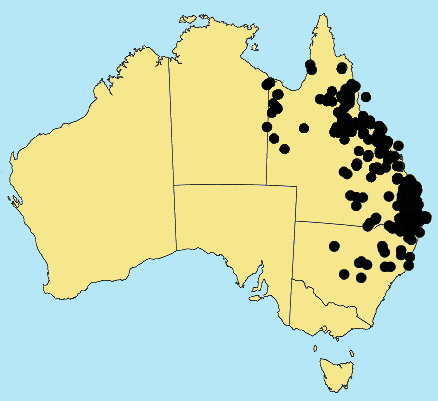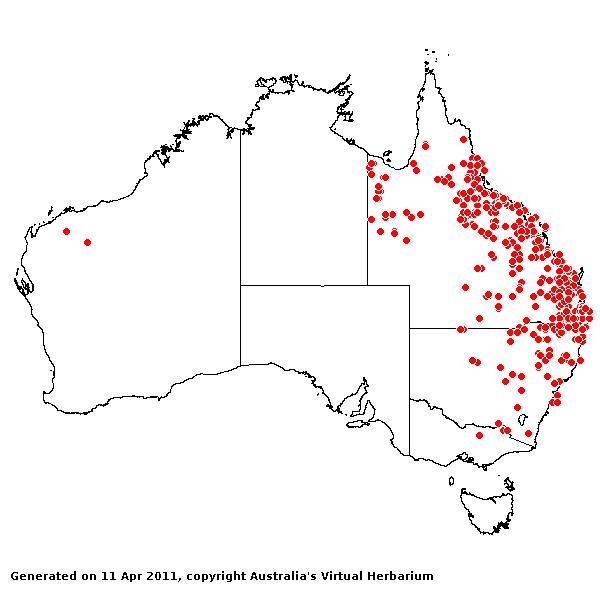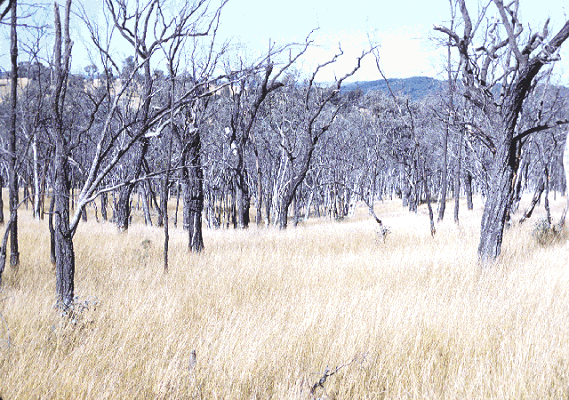Bothriochloa decipiens (Hackel) C. E.
Hubbard. Bull. Misc. Inform. 444 (1934).
Classification.
(GPWG 2001) : Subfamily Panicoideae. Micraireae.
Basionym and/or
Replacement Name: Andropogon
pertusus var. decipiens Hack., Monogr. Phan. 6: 483 (1889).
Type of Basionym or
Protologue Information: Australia, Queensland, pr. Rockhampton, O'Shannon
s.n..
Key references
(books and floras): [2002] D.Sharp & B.K.Simon, AusGrass, Grasses of
Australia, [2008] S.W.L.Jacobs, R.D.B.Walley & D.J.B.Wheeler, Grasses
of New South Wales (168).
Illustrations:
[1983] J.C.Tothill & J.B.Hacker, Grasses of Southern Queensland
(128(9) & 130), [2008] S.W.L.Jacobs, R.D.B.Whalley & D.J.B.Wheeler, Grasses
of New South Wales, 4th edn (168).
Habit.
Perennial. Culms erect or geniculately ascending, 30–200 cm tall, 5–9 -noded.
Mid-culm nodes glabrous. Lateral branches simple or sparsely branched or
branched. Leaves mostly basal. Leaf-sheaths glabrous on surface or hairy.
Ligule a fringed membrane, a ciliolate membrane, 0.75–1.5 mm long, truncate.
Leaf-blades flat or revolute, 6–25 cm long, 2–6 mm wide. Leaf-blade surface
glabrous or indumented.
Inflorescence.
Inflorescence subdigitate, with ramose branches. Racemes 4–7 cm long. Central
inflorescence axis 0.6–1.3 cm long. Rhachis fragile at the nodes.
Spikelets.
Spikelets sessile, 1 in the cluster. Companion spikelets pedicelled, 1 in the
cluster. Companion spikelets represented by single glumes, 2.5–3.75 mm long.
Fertile spikelets 2-flowered, the lower floret barren (rarely male), the upper fertile,
comprising 1 basal sterile florets, comprising 1 fertile floret(s), without
rachilla extension, lanceolate, dorsally compressed, 4.75–5.25 mm long.
Glumes. Glumes
dissimilar, firmer than fertile lemma. Lower glume elliptic, cartilaginous,
without keels, 7–9 -nerved. Lower glume surface indumented. Upper glume
lanceolate, keeled, 1-keeled, 3 -nerved. Upper glume surface asperulous. Florets.
Basal sterile florets 1, barren, without significant palea. Lemma of lower
sterile floret 60 % of length of spikelet, hyaline.
Fertile lemma 1.75–2
mm long, without keel. Lemma apex entire, awned, 1 -awned. Median (principal)
awn apical, 15–24 mm long overall, with a twisted column. Palea absent. Anthers
1. Grain 1.85–2.5 mm long.
Continental
Distribution: Australasia.
Australian
Distribution: Western Australia, Northern Territory, Queensland, New South
Wales.
Northern Territory:
Barkly Tableland. Queensland: Burke, Burnett, Cook, Darling Downs,
Gregory North, Leichhardt, Maranoa, Mitchell, Moreton, North Kennedy, Port
Curtis, South Kennedy, Warrego, Wide Bay. New South Wales: North Coast,
Central Coast, Central Tablelands, North-Western Slopes, Central-Western
Slopes, South-Western Slopes, North-Western Plains, South-Western Plains.
Notes.
A widespread grass in open forest country of subtropical N.S.W. and Qld and
tropical Qld. It is not as palatable as some of the other native species and
sometimes becomes locally dominant where preferred species have been grazed
out. There are two varieties.
Slender plants to 100 cm tall; leaf lamina
somewhat hairy 9a. var. decipiens
Robust plants 100–200 cm tall; leaf lamina
glabrous 9b. var. cloncurrensis




